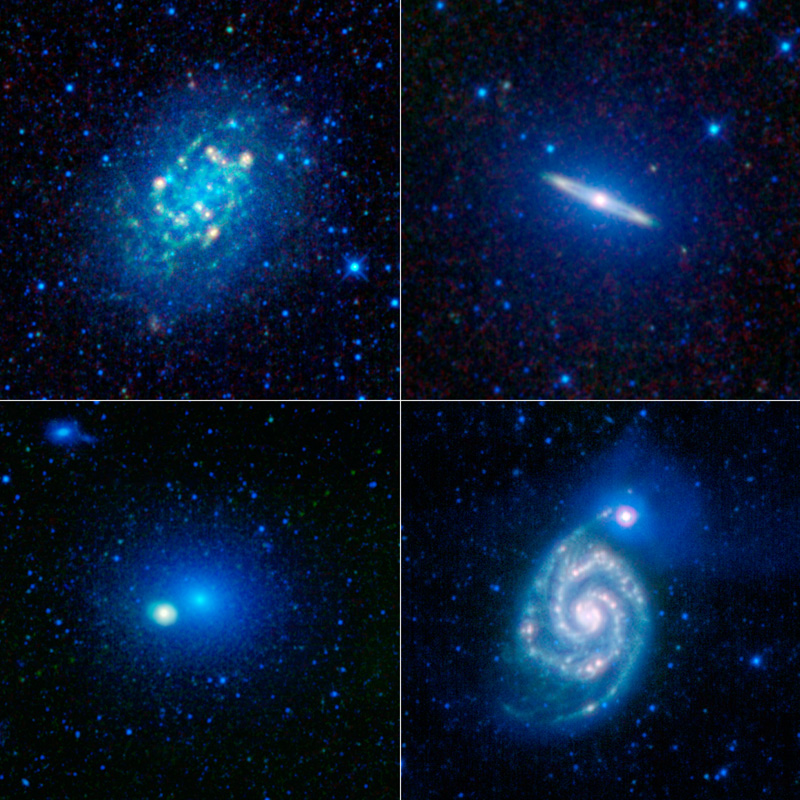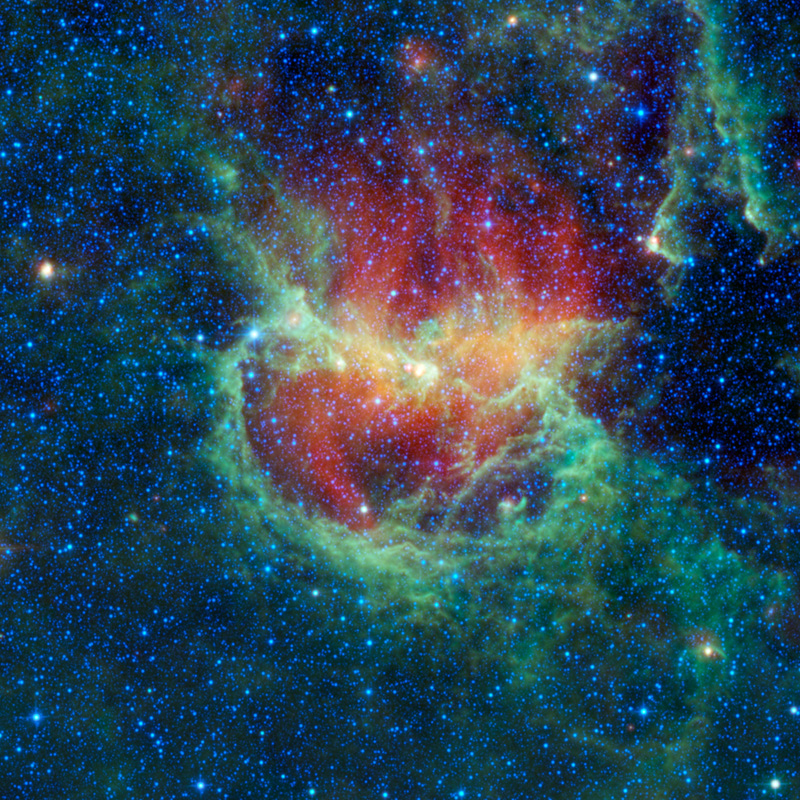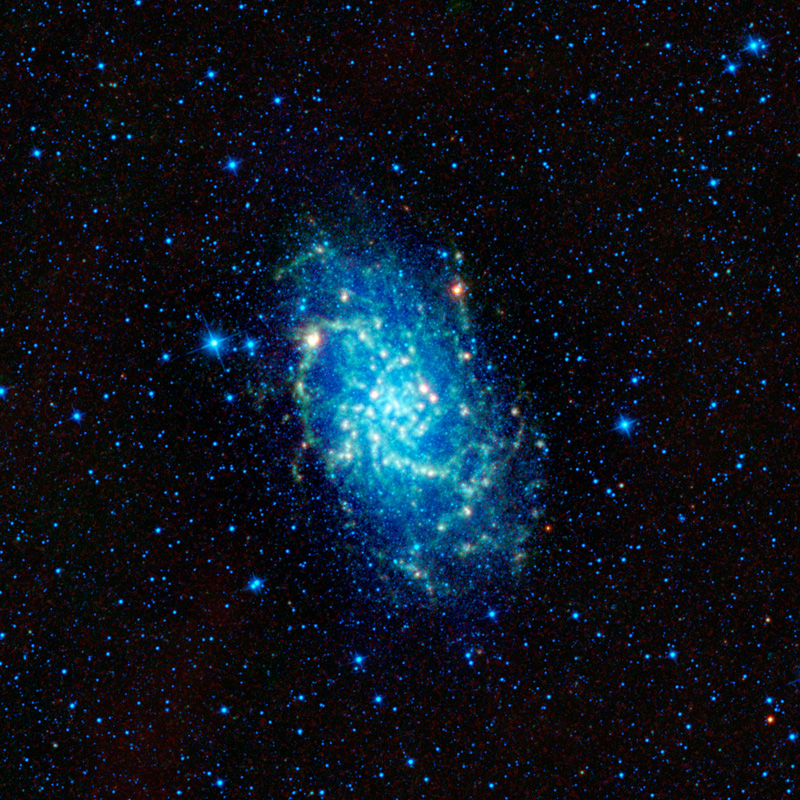To celebrate the one-year anniversary of the launch of NASA’s Wide-Field Infrared Explorer, or WISE, the mission team has put together this image showing just a sample of the millions of galaxies that have been imaged by WISE during its survey of the entire sky.
NGC 300 is seen in the image in the upper left panel. This is a textbook spiral galaxy. In fact, it is such a good representation of a spiral galaxy that astronomers have studied it in great detail to learn about the structure of all spirals in general. Infrared images like this one from WISE show astronomers where areas of gas and warm dust are concentrated -- features that cannot be seen in visible light. This gas and dust is primarily found near star-forming regions in the spiral arms. There isn’t a significant amount of gas and dust in the central core in this type of spiral galaxy, so it appears relatively dim. At about 39,000 light-years across, NGC 300 is only about 40 percent the size of the Milky Way Galaxy.
The upper right image shows Messier 104, or M104, also known as the Sombrero galaxy. Although M104 is also classified as a spiral galaxy, it has a very different appearance than NGC 300. In part, this is because the dusty, star-forming spiral disk in M104 is seen nearly edge-on from our point of view. M104 also has a large, ball-shaped bulge component of older stars, seen here in blue. In visible light, a dark dust lane extends across the galaxy, blocking out some of the bright starlight in the disk behind it, and causing it to resemble a sombrero. This dust lane encircles the entire galaxy and glows brightly in infrared; it is seen here as bright circle surrounding a dense galactic core.
The large, fuzzy grouping of stars at the center of the lower left panel is the galaxy Messier 60, or M60. This galaxy does not have a spiral disk, just a bulge, making it a massive elliptical galaxy. M60 is about 20 percent larger than the Milky Way Galaxy, and lies in the Virgo cluster of galaxies. The brighter dense spot inside but off-center from the blue core of M60 is a separate spiral galaxy called NGC 4647. In visible light, M60 is much brighter than NGC 4647. However, in the longest infrared wavelengths that WISE sees, the opposite is true. Recent evidence suggests there is a black hole at the center of M60 with a mass of about 4.5 billion times that of the Sun, making it one of the largest black holes known. Two more galaxies are near the upper left corner of this panel, NGC 4638 (the brighter one) and NGC 4637. In addition, two different asteroids were caught crossing the field of view when WISE imaged this portion of the sky (dotted green lines extending out from M60 at about the 2 o’clock and 8 o’clock positions).
The galaxy in the lower right panel is Messier 51, or NGC 5194, also frequently referred to as the Whirlpool galaxy. The Whirlpool is a "grand design" spiral galaxy. It is interacting with its smaller companion -- NGC 5195, a dwarf galaxy, which can be seen as a bright spot near the tip of the spiral arm extending up and to the right of the larger galaxy. The Whirpool's very bright spiral arms show areas of compressed dust and gas. These arms have been enhanced by the recent encounter with NGC 5195.
These images were made from observations by all four infrared detectors aboard WISE. Blue and cyan represent infrared light at wavelengths of 3.4 and 4.6 microns, which is primarily light from stars. Green and red represent light at 12 and 22 microns, which is primarily light emitted from warm dust.
WISE launched into space aboard a Delta II rocket on Dec. 14, 2009, from Vandenberg Air Force Base, Calif.
Credit: NASA/JPL-Caltech/WISE Team
JPL: WISE Mission Image Releases 2010
WISE: A Collage of Nearby Galaxies
A Collage of Nearby Galaxies | 14 Dec 2010
Know the quiet place within your heart and touch the rainbow of possibility; be
alive to the gentle breeze of communication, and please stop being such a jerk. — Garrison Keillor
alive to the gentle breeze of communication, and please stop being such a jerk. — Garrison Keillor
WISE: IC 2944: Lamda Centauri Nebula
Chasing Chickens in the Lambda Centauri Nebula | 21 Dec 2010
This image from the Wide-field Infrared Survey Explorer, or WISE, is an infrared view of a star forming cloud in our Galaxy called the Lambda Centauri nebula, also known as the Running Chicken nebula. The nebula, cataloged as IC 2944, is about 5,800 light-years from Earth and home to a new cluster of stars born from the cloud nearly 8 million years ago. The hottest members of the cluster produce enough ultraviolet radiation and strong winds to both ionize and excavate the cloud. The ionized gas glows in visible light, but in infrared light we see the dust in the cloud warmed by the very same radiation. The dust glowing red is the coolest material seen in this image and is composed of metallic dust grains. The greenish components in the image are warmer dust grains composed of smog-like materials. The large green ring-like structure near the middle of the image is some 77 light-years across and is formed by the combined winds of the stars in the clusters blowing back the material from which they were born.
The nebula gets its common name from its appearance in some visible light images to a running chicken. It is also called the Lambda Centauri nebula because it appears to surround the bright star Lambda Centauri. Lambda Centauri is one of the brightest stars in the constellation Centaurus. The brightest stars in the sky are named based on the constellation they are in. For example, the brightest star in the constellation Centaurus is Alpha Centauri, the next brightest star in that constellation is Beta Centauri, and so forth. Lambda Centauri is therefore the 11th brightest star in the constellation Centaurus. It is not so bright in infrared light, however. In this WISE image, it appears as the dimmer, lower, and bluer of two bright stars in the upper right-hand corner of the image. It is a blue giant star about 410 light-years away. So, in fact, Lambda Centauri is much closer to Earth than IC 2944 and has nothing to do with the nebula at all.
This image is a four-color composite created by all four of WISE’s infrared detectors. Color is representational: blue and cyan represent infrared light observed at wavelengths of 3.4 and 4.6 microns, which is mostly light from stars. Green and red represent light observed at 12 and 22 microns, which is mostly light from warm dust, with red indicating temperatures lower than green.
Credit: NASA/JPL-Caltech/WISE Team
Know the quiet place within your heart and touch the rainbow of possibility; be
alive to the gentle breeze of communication, and please stop being such a jerk. — Garrison Keillor
alive to the gentle breeze of communication, and please stop being such a jerk. — Garrison Keillor
WISE: M33: Triangulum Galaxy
WISE Spies a Galactic Neighbor | 28 Dec 2010
This image captured by NASA’s Wide-field Infrared Survey Explorer, or WISE, shows of one of our closest neighboring galaxies, Messier 33. Also named the Triangulum Galaxy (after the constellation it’s found in), M33 is one of largest members in our small neighborhood of galaxies -- the Local Group. The Local Group consists of about 30 galaxies that are gravitationally bound and travel together through the Universe. M33 is the third largest member of the Local Group, dwarfed only by the Andromeda Galaxy (M31) and our very own home galaxy, the Milky Way.
M33 is extremely close as far as galaxies go, residing only 3 million light years away. Its proximity, along with it being conveniently tilted towards Earth (about 54 degrees to the line of sight), make it very easy for astronomers to study in detail. The infrared images that WISE produces contribute to astronomers’ overall understanding of a variety of processes happening in the galaxy. Areas in the spiral arms that are hidden behind dust in visible light shine through brightly in infrared light, showing where clouds of cool gas are concentrated. Star-forming regions are easy to spot in infrared (green and red areas in this image). Notice that there isn’t a lot of star formation occurring near the center of M33. It would be difficult to deduce this lack of activity in the core by only looking a visible light image, where the core appears to be the brightest feature. This infrared image also shows that the galaxy is surprisingly bigger than it appears in visible light. The cold dust seen by WISE extends much further out from the core than anticipated.
The bright yellow-orange ‘blobs’ scattered throughout M33 are areas where stars are forming at an especially intense rate. The largest one in the spiral arm to the upper left has its own name, NGC 604. It’s an H II region -- an area of gas that is being heated and ionized by powerful young stars recently born inside of it. The Orion Nebula is an example of a nearby H II region within our own Milky Way Galaxy. NGC 604, however, is the largest such region in the entire Local Group of galaxies. It is over 40 times larger than the Orion Nebula and much brighter. If NGC 604 were at the same distance from Earth as the Orion Nebula it would be the brightest object in the night sky (besides the Moon).
M33 is over 50,000 light years across (about half the size of the Milky Way). Because it is so close it appears quite large to us, covering a piece of sky nearly 4 times bigger than the full Moon. Its relatively low surface brightness makes it difficult for human eyes to see, however. Even so, under exceptionally dark skies it can be seen with the unaided eye, making it one of the furthest objects visible without a telescope.
These images were made from observations by all four infrared detectors aboard WISE. Blue and cyan represent infrared light at wavelengths of 3.4 and 4.6 microns, which is primarily light from stars. Green and red represent light at 12 and 22 microns, which is primarily light emitted from warm dust.
Credit: NASA/JPL-Caltech/WISE Team
Know the quiet place within your heart and touch the rainbow of possibility; be
alive to the gentle breeze of communication, and please stop being such a jerk. — Garrison Keillor
alive to the gentle breeze of communication, and please stop being such a jerk. — Garrison Keillor
Re: WISE: M33: Triangulum Galaxy
A WISE view of a small neighborbystander wrote:WISE Spies a Galactic Neighbor | 28 Dec 2010
http://wise.ssl.berkeley.edu/gallery_im ... 47-med.jpg
Discover Blogs | Bad Astronomy | 2011 Jan 03
What shall be the first astronomical object to grace this blog in 2011*? With a whole sky to choose from, why not use an old friend, but seen in a surprisingly new way? So I present to you the nearby Triangulum Galaxy, M33, as seen by the orbiting far-infrared telescope WISE: (see above)
M33 is familiar to pretty much any serious amateur astronomer north of the Equator. It’s not that far in the sky from its bigger buddy M31, the Andromeda Galaxy, and in fact isn’t terribly far in space either; Andromeda is about 2.5 million light years away, while M33 is about 3 million. M33 is a spiral galaxy as well, and one of the closest to us.
Andromeda is probably the most well-known galaxy in the sky. So why is M33 so less famous? Mostly because it’s smaller; Andromeda and the Milky Way are roughly the same size (so close, in fact, that astronomers have been arguing for decades over which is the beefier of the two, and the title has swapped back and forth many times), but M33 is only half our size. Also, it’s more face-on to us, spreading its light out, making it actually a somewhat tough object to see. I’ve seen it in binoculars from dark sites, but it’s only marginally brighter than the sky background.
In the WISE image, blue and cyan are from infrared light at 3.4 and 4.6 microns (roughly 5 and 6.5 times the reddest light your eye can see). That comes mostly from stars. Green and red are IR at 12 and 22 microns, much farther in the infrared, and comes from cooler material like interstellar dust, which is opaque to visible light.
Here’s a shot of M33 in visible light. It looks a bit different than in the IR, doesn’t it? The core is bright in visible, but basically gone in the infrared. That’s a clear sign that stars aren’t being born there; they create a lot of dust when they form, and that lights up in the IR.
Interestingly, the overall shape of the galaxy in both images is similar. You can trace the spiral arms easily in both, and the WISE image gives you a pretty clear view of where stars are forming. Those bright spots in the the IR shot look like stars, but are pinkish in the visible image, which marks them as gigantic gas clouds where lots and lots of stars are being made — the pink is from the presence of vast quantities of heated hydrogen gas, which shines brightly in red.
See that really bright red-tinged white blob in the WISE picture on the left, smack dab on a spiral arm? That’s one of my favorite objects in the sky, called NGC 604. Doesn’t look like much, does it? That’s because WISE, while a great observatory, actually sports a rather small mirror: just 40 cm (16 inches) across. It was designed to survey the whole sky, and not see small objects in high resolution. However, we have bigger telescopes like, say, Hubble with its 2.4 meter (8 foot) mirror:
Boom! Yeah, now you can see why I love this object; it’s beautiful, intricate, and amazing. NGC 604 is a vast star-forming factory well over 1500 light years across, much bigger even than our own Orion Nebula (which itself is pretty dang big). NGC 604 is so big and bright that were it located as close as Orion, it would be second only to the Moon as brightest object in our night sky!
One other thing about the WISE picture: it’s pretty big. At about 1.5° on a side, over 11 full Moons could fit in this shot! It would take Hubble weeks to take a picture covering that much sky. I’ll note that WISE has to use a cryogen — frozen hydrogen! — to keep its instruments cold, but the coolant ran out in October. Still, it can take images in the shorter two of the four wavelengths of infrared, so it’s still up there scanning the sky. I was surprised to learn that WISE discovered more than 33,000 asteroids, over 100 of which pass near the Earth! That’s phenomenal.
I don’t know how many more beautiful pictures we’ll see from WISE, but I’m glad it’s still up there doing science and keeping its cold eye open for more potentially threatening asteroids. The more, the better.
Know the quiet place within your heart and touch the rainbow of possibility; be
alive to the gentle breeze of communication, and please stop being such a jerk. — Garrison Keillor
alive to the gentle breeze of communication, and please stop being such a jerk. — Garrison Keillor




